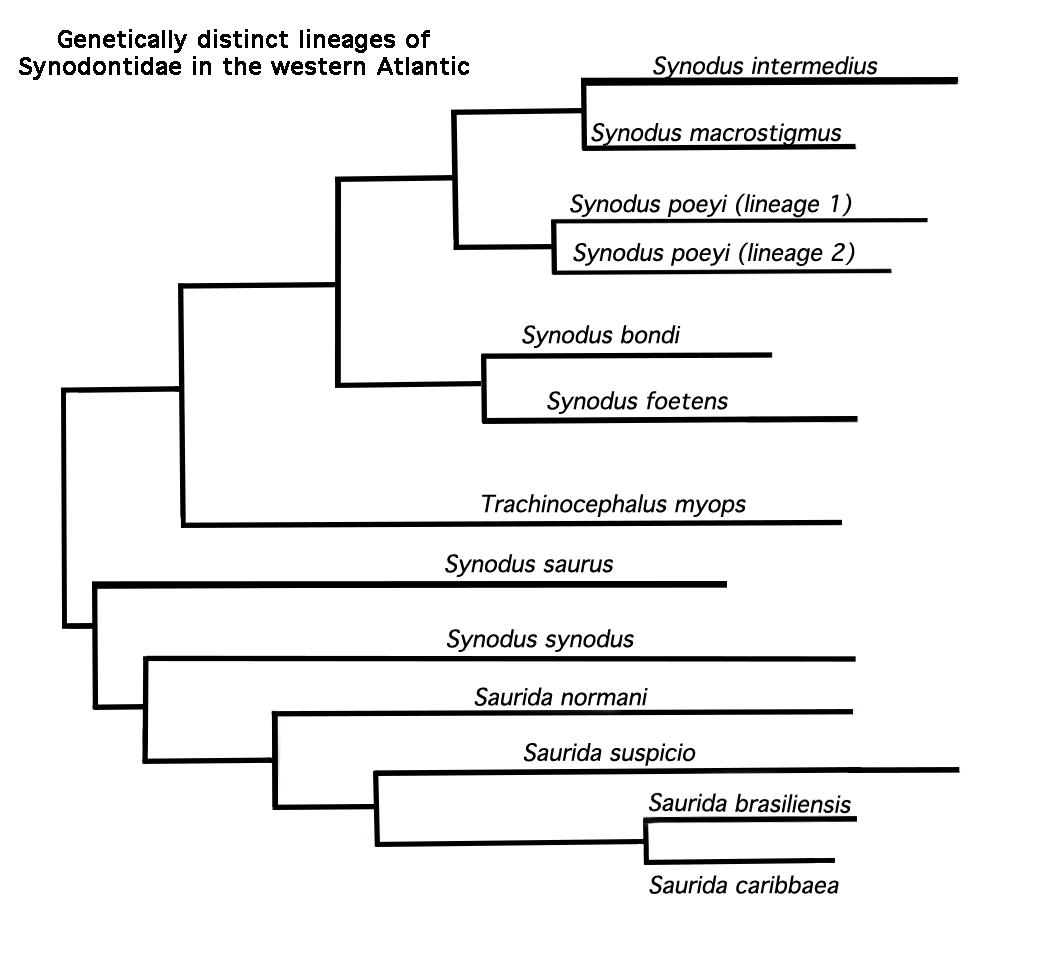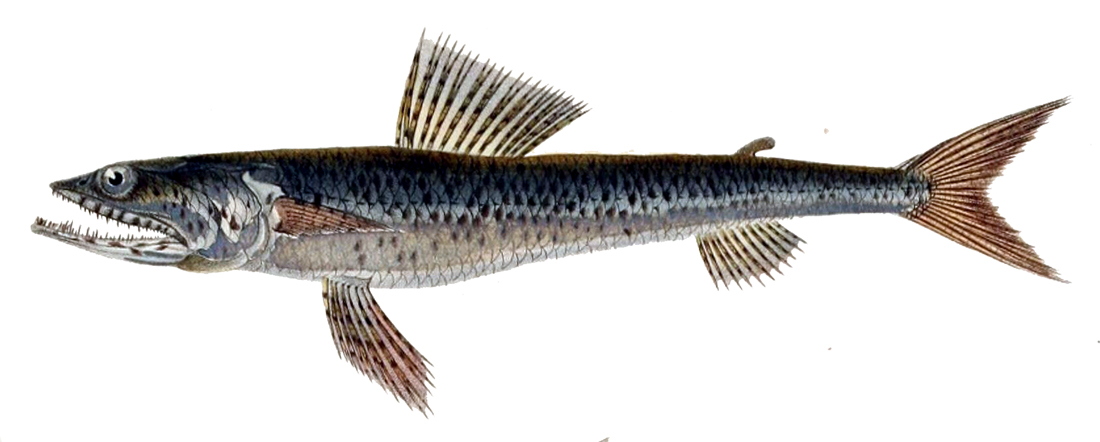|
Lizardfish
The Synodontidae or lizardfishes(or typical lizardfish to distinguish them from the Bathysauridae and Pseudotrichonotidae) are benthic (bottom-dwelling) marine and estuarine bony fishes that belong to the aulopiform fish order, a diverse group of marine ray-finned fish consisting of some 15 extant and several prehistoric families. They are found in tropical and subtropical marine waters throughout the world. Lizardfishes are generally small, although the largest species measures about in length. They have slender, somewhat cylindrical bodies, and heads that superficially resemble those of lizards. The dorsal fin is located in the middle of the back, and accompanied by a small adipose fin placed closer to the tail. They have mouths full of sharp teeth, even on the tongue. Lizardfishes are benthic animals that live in shallow coastal waters; even the deepest-dwelling species of lizardfish live in waters no more than deep. Some species in the subfamily Harpadontinae The H ... [...More Info...] [...Related Items...] OR: [Wikipedia] [Google] [Baidu] |
|
|
Synodus
''Synodus'' is a genus of fish in the family Synodontidae found in Atlantic, Indian, and Pacific Oceans. Species Currently, 46 species in this genus are recognized: * '' Synodus binotatus'' L. P. Schultz, 1953 (two-spot lizardfish) * '' Synodus bondi'' Fowler, 1939 (sharp-nose lizardfish) * '' Synodus capricornis'' Cressey & J. E. Randall, 1978 (capricorn lizardfish) * '' Synodus dermatogenys'' Fowler, 1912 * '' Synodus doaki'' Barry C. Russell & Cressey, 1979 (arrow-tooth lizardfish) * '' Synodus evermanni'' D. S. Jordan & Bollman, 1890 (Inotted lizardfish) * '' Synodus falcatus'' Waples & J. E. Randall, 1989 * '' Synodus fasciapelvicus'' J. E. Randall, 2009 * '' Synodus foetens'' (Linnaeus, 1766) (inshore lizardfish) * '' Synodus fuscus'' S. Tanaka (I), 1917 * '' Synodus gibbsi'' Cressey, 1981 * '' Synodus hoshinonis'' S. Tanaka (I), 1917 (blackear lizardfish) * '' Synodus indicus'' ( F. Day, 1873) (Indian lizardfish) * '' Synodus intermedius'' ( Agassiz, 1829) (sa ... [...More Info...] [...Related Items...] OR: [Wikipedia] [Google] [Baidu] |
|
|
Saurida
''Saurida'' is a genus of fish in the family Synodontidae. Species There are currently 23 recognized species in this genus: * '' Saurida argentea'' W. J. Macleay, 1881 (Short-fin saury) * '' Saurida brasiliensis'' Norman, 1935 (Brazilian lizardfish) * '' Saurida caribbaea'' Breder, 1927 (Small-scale lizardfish) * '' Saurida elongata'' ( Temminck & Schlegel, 1846) (Slender lizardfish) * '' Saurida filamentosa'' J. D. Ogilby, 1910 (Thread-fin lizardfish) * '' Saurida flamma'' Waples, 1982 (Orange-mouth lizardfish) * '' Saurida golanii'' B. C. Russell, 2011 (Golani's lizardfish) Russell, B.C. (2011): ''Saurida golanii'', a new deep water lizardfish (Pisces: Synodontidae) from the Gulf of Aqaba, northern Red Sea. ''Zootaxa, 3098: 21-25.'' * '' Saurida gracilis'' ( Quoy & Gaimard, 1824) (Gracile lizardfish) * '' Saurida isarankurai'' Shindo & Yamada, 1972 (Short-jaw saury) * '' Saurida lessepsianus'' B. C. Russell, Golani & Tikochinski, 2015 (Lessepsian lizardfish) Russell ... [...More Info...] [...Related Items...] OR: [Wikipedia] [Google] [Baidu] |
|
|
Synodus Saurus
The Atlantic lizardfish ''(Synodus saurus)'', is a species of lizardfish The Synodontidae or lizardfishes(or typical lizardfish to distinguish them from the Bathysauridae and Pseudotrichonotidae) are benthic (bottom-dwelling) marine and estuarine bony fishes that belong to the aulopiform fish order, a diverse grou ... that primarily lives in the Eastern Atlantic. Information The Atlantic lizardfish is known to be found in a marine environment within a general demersal depth range of about 400 meters. They are more specifically found in a depth range of about 20 meters. This species is native to a subtropical climate. The maximum recorded length of the Atlantic lizardfish as an unsexed male is about 40 centimeters or about 15.74 inches. The distribution of this species occupies the areas of Eastern Atlantic, Morocco, Cape Verde, Azores, Mediterranean, Western Atlantic, Bermuda, Bahamas, Lesser Antilles, and the Leeward Islands. This species is mainly known to be found in ins ... [...More Info...] [...Related Items...] OR: [Wikipedia] [Google] [Baidu] |
|
 |
Synodus Intermedius
''Synodus intermedius'', the common sand diver,Sand diver at NCBISand diver at is a species of fish in the family, the Synodontidae, a |
 |
Deepsea Lizardfish
The deepsea lizardfish, ''Bathysaurus ferox'', is an aulopiform of the family Bathysauridae, found in tropical and subtropical seas across the world. The deepsea lizardfish should not be confused with the true or "typical" lizardfishes of the related family Synodontidae. Taxonomy Deepsea lizardfishes were first described in 1878 by British zoologist Albert Günther, who created the generic name from ancient Greek word elements “''báthos''” and “''saûros''” meaning “lizard of the depths”. Previously recognized in the synodontidae, in 1996, Robert Karl Johnson et al. showed its relationships outside synodontidae, in its own family in the suborder Giganturoidei. At the beginning of the century, ''Bathysaurus ferox'' larvae were thought to be a distinct species called ''Macristium chavesi''. Johnson gave evidence of the synonymy of the two species. Appearance Deep-sea lizardfish resemble shallow-water lizardfishes, as reflected in their common names. Adults reach ... [...More Info...] [...Related Items...] OR: [Wikipedia] [Google] [Baidu] |
 |
Synodus Synodus
The diamond lizardfish ''(Synodus synodus)'' is a species of lizardfish that lives in tropical and subtropical waters of the Atlantic Ocean. Information The diamond lizardfish has been found within marine environments within reef-associated areas. This species lives generally in the depth range of 2 – 35 m. The species is native to the subtropical climate. The maximum recorded length of the diamond lizardfish as an unsexed or male was about 33 cm (1.1 ft) long. The common length of this species is about 20 cm or 8 inches. It is commonly identified by the dark red stripes on its back. The diamond lizardfish is commonly found in shallow, inshore waters, and is known to prefer to stay on hard surfaces rather than sandy bottoms. It also can be found in reef areas and also goes into open shelf water as deep as 90 m. This species is edible and has been recorded to taste relatively good, but it is not commonly eaten. The diamond lizardfish is occasionally caught with artisanal gear u ... [...More Info...] [...Related Items...] OR: [Wikipedia] [Google] [Baidu] |
 |
Synodus Foetens
The inshore lizardfish (''Synodus foetens'') is a member of the family SynodontidaeRussell, B., Polanco Fernandez, A., Moore, J. & McEachran, J.D. 2015. Synodus foetens. The IUCN Red List of Threatened Species 2015: e.T16441698A16509727. https://dx.doi.org/10.2305/IUCN.UK.2015-4.RLTS.T16441698A16509727.en. Downloaded on 1 May 2017. found in the western Atlantic. Description The inshore lizardfish has a maximum length recorded of about 50 cm but generally we see them at about 40 cm long. Their lifespan can be up to nine years. The body of this species is elongated, similar to a cigar.Harry, Shivrani. "Synodus foetens (Inshore Lizardfish)." The Online Guide to the Animals of Trinidad and Tobago . UWI, 2016. Web. 30 Apr. 2017. The maximum weight has been seen as 900 g. Females are generally larger than males when mature. The shape of the mouth of this species is large and pointed. The snout is pointed. The top jaw extends beyond the eye. Many slender teeth are present ... [...More Info...] [...Related Items...] OR: [Wikipedia] [Google] [Baidu] |
 |
Aulopiformes
Aulopiformes is a diverse order of marine ray-finned fish consisting of some 15 extant and several prehistoric families with about 45 genera and over 230 species. The common names grinners, lizardfishes and allies, or aulopiforms are sometimes used for this group. The scientific name means "''Aulopus''-shaped", from '' Aulopus'' (the type genus) + the standard fish order suffix "-formes". It ultimately derives from Ancient Greek ''aulós'' (αὐλός, "flute" or "pipe") + Latin ''forma'' ("external form"), the former in reference to the elongated shape of many aulopiforms.FishBase (2000) They are grouped together because of common features in the structure of their gill arches. Indeed, many authors have considered them so distinct as to warrant separation in a monotypic superorder of the Teleostei, under the name Cyclosquamata. However, monotypic taxa are generally avoided by modern taxonomists if not necessary, and in this case a distinct superorder seems indeed unwarran ... [...More Info...] [...Related Items...] OR: [Wikipedia] [Google] [Baidu] |
 |
Bathysauridae
The Bathysauridae are a small family of deepwater aulopiform fish, related to the telescopefishes. The two species in the family both belong to the genus ''Bathysaurus''. Commonly called deepwater lizardfishes or deepsea lizardfishes, the latter name usually refers to the species ''B. ferox'' specifically. Physically, the bathysaurids resemble the lizardfishes, as reflected in their common names. They can be distinguished from the lizardfishes by their flatter heads and curved and barbed teeth. They are moderately sized fish, up to in length. Bathysaurids inhabit the deep oceans, below depth. They are one of the world's deepest living apex predators, and will not hesitate to eat anything they meet, including their own kind. Their larvae were originally believed to represent a distinct genus (''Macristium'') and even family. The two Bathysaurid species, ''Bathysaurus mollis'' and ''Bathysaurus ferox'' are hermaphrodite In reproductive biology, a hermaphrodite () is a ... [...More Info...] [...Related Items...] OR: [Wikipedia] [Google] [Baidu] |
|
Saurida Undosquamis
''Saurida undosquamis'', the brushtooth lizardfish, large-scale grinner or largescale saury, is a type of lizardfish, a demersal species that occurs in the Eastern Indian Ocean, Malay Peninsula, northern Java, Arafura Sea, Louisiade Archipelago, southern Philippines and northern Australia,.Allen, G.R. (1997): Marine Fishes of Tropical Australia and South-East Asia. Western Australian Museum. 292 pp.Russell, B.C., 1999. Synodontidae: lizardfishes (also bombay ducks, sauries). p. 1928-1945. In K.E. Carpenter and V.H. Niem (eds.) FAO species identification guide for fishery purposes. The living marine resources of the Western Central Pacific. Vol. 3. Batoid fishes, chimaeras and bony fishes. Part 1 (Elopidae to Linophrynidae). FAO, Rome. pp. 1397-2068. Reports of its occurrence in the Red Sea region and introduction to the Mediterranean are questionable,.Mahmoud, H.H., El Haweet, A.A.K. & Dimech, M. (2014): Stock assessment of the alien species Brushtooth lizard fish, ''Saurida undosq ... [...More Info...] [...Related Items...] OR: [Wikipedia] [Google] [Baidu] |
|
|
Saurida Tumbil
The greater lizardfish ''(Saurida tumbil)'' is a species of lizardfish that lives in the Indo-Pacific. They are a minor fishery. Distribution They live in the Indo-West Pacific. More specifically, their geographic range spans from Red Sea and east coast of Africa (except Kenya), including Madagascar to the Persian Gulf, Arabian Sea, and further east to southeast Asia Southeast Asia, also spelled South East Asia and South-East Asia, and also known as Southeastern Asia, South-eastern Asia or SEA, is the geographical United Nations geoscheme for Asia#South-eastern Asia, south-eastern region of Asia, consistin ... and Australia but they do not appear to occur in the central or eastern Pacific. Short description Its average length at maturation is (range 19–35 cm) and maximum length is fork length. They have neither dorsal spines nor anal spines but display 11–13 dorsal soft rays (total) and 10–11 anal soft rays. Body is cigar-shaped, rounded or slightly compre ... [...More Info...] [...Related Items...] OR: [Wikipedia] [Google] [Baidu] |
|
|
USS Lizardfish
USS ''Lizardfish'' (SS-373), a ''Balao''-class submarine, was a boat of the United States Navy named for the lizardfish, a slender marine fish having a scaly, lizard-like head and large mouth. Construction and commissioning ''Lizardfish'' was laid down on 14 March 1944 by the Manitowoc Shipbuilding Company at Manitowoc, Wisconsin; launched on 16 July 1944, sponsored by Mrs. Lansdale G. Sasscer; wife of Congressman Sasscer of Maryland; and commissioned on 30 December 1944. Operational history World War II ''Lizardfish'' departed the Manitowoc River 20 January 1945 for Lockport, IL, where she was loaded on a floating drydock and towed down the Mississippi River. She arrived at Algiers, La., 1 February and put to sea 5 days later for the Panama Canal and Pearl Harbor, arriving 23 March. ''Lizardfish'' left Pearl Harbor on her first war patrol 9 April 1945. Topping off with fuel at Saipan on the 21st, she set course for the South China Sea. The submarine maintained a thoro ... [...More Info...] [...Related Items...] OR: [Wikipedia] [Google] [Baidu] |